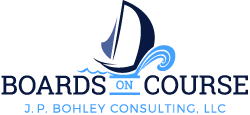Tip #46 Manage Your Board Group Process Effectively: The Fourth "P" for Building Your Board Team
We have identified 4 P’s for Building Your Board Team: Purpose, People, Plan and Process. After covering the first 3 P’s in our last three Tips for Effective Boards, we now turn to the fourth P: Manage Your Board Group Process Effectively.
First of all, let’s clarify what we mean by group process. Certainly board members need to be focused on the topics being discussed. But if the discussion is to be productive, board members need at the same time to be aware not only about WHAT is being discussed but HOW it is being discussed. The HOW of the discussion is what is meant by group process. Group process includes such considerations as: Is everyone participating or is the discussion being dominated by a few board members? Are new ideas being expressed and welcomed by other board members? Are differing viewpoints encouraged? Are disagreements expressed and responded to respectfully? Are conflicts resolved constructively? How are we managing our meeting time? Are we staying on task or have we gone off on a tangent?
Of course, the person chairing the board meeting has a special responsibility to be attuned to and responsive to group process issues but it is important to create the expectation that all board members share responsibility for the success of the board meeting and assist in maintaining effective group process.
Being aware of group process may sound simple but it can be difficult to do. It takes personal commitment and practice to be able to focus and respond to process issues while being focused on the content being discussed. Some practical suggestions include: ensure that your chair has training in group process facilitation, encourage all board members to be attentive to group process issues, consider identifying one board member (perhaps on a rotating basis) to make a special effort to be attentive to group process issues and speak up with observations during boardroom discussions and/or at the end of the board meeting, establish a listing of norms or ground rules for boardroom discussions, provide an opportunity for all board members to provide feedback at the end of each meeting about the HOW or group process of the meeting. This feedback could be provided vocally at the meeting or through brief written questionnaires collected and collated by the board secretary or other designated board member for discussion at the next board meeting. (For suggestions about ground rules for board meetings, please check out Blog Tip 39: Establish Ground Rules for Effective Board Meetings by clicking https://www.BoardsOnCourse.com/blog. For a suggested end-of-meeting questionnaire, please click https://www.BoardsOnCourse.com/resources.)
In our next three Tips for Effective Boards, we’ll provide specific group process tips:
- Tips for engaging all board members in boardroom discussions.
- Tips for encouraging creative thinking in the boardroom.
- Tips for managing disagreements and conflicts proactively and constructively.
The 4 P’s incorporate insights from the Policy Governance® model developed by John Carver, from other governance writers and from the group dynamics and team-building literature.
Please take the time to check out the Policy Governance® model. It provides a comprehensive board governance design that supports and enhances effective group process. For more information about the Policy Governance® model click https://www.BoardsOnCourse.com/policy-governance or contact me at jpbohley@gmail.com.
I will be happy to customize a workshop for your board on any or all of the 4 P’s or on the Policy Governance® model which provides an excellent governance design for the 4 P’s. If you would like more information, please respond to this email or contact me via jpbohley@gmail.com.
To read other Tips for Effective Boards, click https://www.BoardsOnCourse.com/blog.
